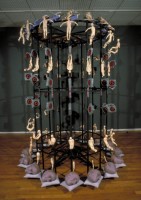GREGORY BARSAMIAN
Die Falle
source:
The gap between what the mind perceives and what’s actually taking place in reality is exploited by New York artist Gregory Barsamian, in his uncanny animated sculptures that use strobe lights to take the surreal images from our dreams and bring them to life in eerie, jerky movements.
In his piece Die Falle (The Trap), dreaming disembodied heads release shapeless blobs that turn into human forms, and give you the illusion that they’re gliding up a spinning steel armature, turning into cogs and then back to humans before being snapped up by mouse trap beds. Watching it mutate and transform before your eyes is transfixing and disturbing. Barsamian takes his inspiration from the unconscious, as he explained to us at London’s Kinetica Art Fair.
In particular, he’s intrigued by the ideas in the analytical psychology of Carl Jung, which he brings to sculptural life using the idea of persistence of vision and a zoetrope-type technique. This accounts for the illusionary quality and motion of Die Falle—the half-real, waking dream effect that it conjures in the viewer’s mind. It has the same unnerving, but hypnotic sensation of the supernatural stop-motion effects of early cinema, like the monster in King Kong (1933)—another exploration of Jungian archetypes and ideas.


